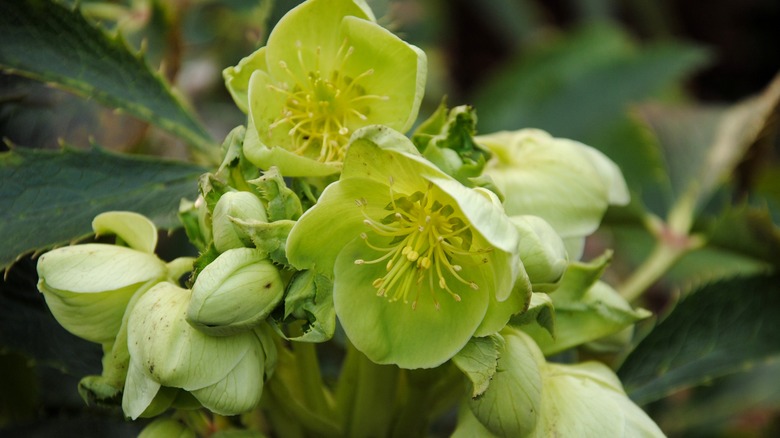Grow This Gorgeous Martha Stewart-Approved Flower For A Classic Spring Garden Bed
Any plant highly recommended by home and garden maven Martha Stewart definitely deserves our attention. Stewart has blogged multiple times about one of the stars of her early spring garden, and we don't blame her. Hellebores, the beautiful little flowers that captured Martha Stewart's heart, are a perfect springtime addition to almost every shade or woodland garden.
There are a variety of hellebores growing on the grounds around Martha Stewart's home in Bedford, New York. Stewart posted on her blog about the gorgeous hellebore flowers in April 2022, describing them as "must-haves for any gardener's collection" and shared pictures of some of her own beautiful hellebores. Stewart's hellebores range in color from almost black to purple, pink, and even a pale cream. She noted that at her farm in New York state, the hellebores generally bloom from March through May and provide color and life when many other flowering plants are still dormant.
How to grow hellebores
Hellebore refers to multiple species in the genus Helleborus, with Helleborus niger and Helleborus hybridus being among the most common. Helleborus niger are hardy in zones 3 through 8 and are sometimes called Christmas roses because of how early they bloom in warm regions. Helleborus hybridus generally bloom slightly later, earning them the name Lenten roses, and they are hardy in zones 4 through 9.
Both species of hellebores appreciate full to partial shade and grow best in alkaline to neutral soil. While Lenten roses can grow up to 2 feet tall and almost 3 feet wide, Christmas roses generally stay smaller and rarely grow more than 1 foot tall. Hellebores are generally evergreen, with their tough leaves visible year-round, even in the dead of winter. Their flowers are also shockingly long-lasting because the colorful parts that look like petals are actually the plant's sepals and can remain on the hellebore for months. Because hellebores are toxic, they are generally left alone by deer, squirrels, and other animals.
Using hellebores in your garden and home
As hellebores grow best in shade, they're a perfect choice for bringing late winter and early spring color to woodland gardens. Hellebores are available in a variety of colors and patterns and can suit almost any color scheme and garden style. As most varieties remain relatively petite, they can be excellent options for the front and middle of borders, allowing other plants to grow up around them during the summer and shelter them from the intense sun.
Hellebores can be a perfect complement to other early-blooming flowers like Fritillaria, snowdrops and Hyacinths, working together to create a vibrant winter garden, even when there's still snow on the ground. The bright flowers of hellebores also look stunning against evergreen shrubs like holly, arborvitae, and juniper. Hellebores with lighter-colored flowers are especially eye-catching as their bright colors provide contrast in shade gardens. They also make excellent cut flowers thanks to their long vase life. Just be sure to keep your hellebore arrangements out of reach of children and pets as all parts of the plant are toxic.


